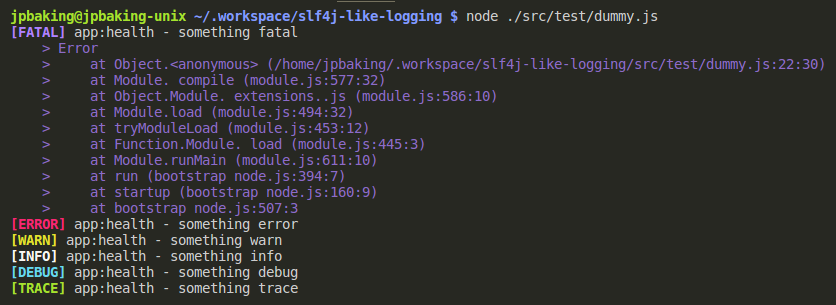Releases: jpbaking/slf4n-logging
slf4n-logging-1.0.0
slf4n-logging
Simple Logging Facade for NodeJS
Emulating Simple Logging Facade for Java (SLF4J)
This shiz is asynchronous!
Yes, logger functions' implementation for writing to streams won't be a blocker.
Every log method returns a bluebird Promise -- for those that want to "wait" for logs to be written before proceding to next lines.
How to use?
Basic Usage
Simply require('slf4n-logging') from your "main" (entrypoint) .js then all of other modules would get the global LoggerFactory.
Sample File #1: app.js
require('slf4n-logging');Sample File #2: api/controller/health.js
const log = LoggerFactory.getLogger('app:health');
// ...
log.debug('some debug line %s', aStringVariable);
log.debug('some debug line %o', anObjectOrArray);
// ...
log.error('some error line', error);Formatting in log.{level}([data][, ...args])
As shown in the example above, syntax for log-level functions exactly the same as require('util').format(format[, ...args]) and console.log([data][, ...args]).
Safe Usage
Some do not like adding anything to global.*. If you're one of those, you may use require('slf4n-logging/safe') instead:
Sample File: api/helpers/UltimateHelper.js
const log = require('slf4n-logging/safe')('app:ultimate');
// ...
log.info('some info line');
// ...
log.warn('some warn line', error);"Manual" Usage
Sample loggerConfig object:
// example
const loggerConfig = {
layout: '[:level] :timestamp :logger - :message:error',
errorIndenter: ' > ',
level: 'trace',
colors: {
enabled: 'true',
fatal: 'magenta',
error: 'red',
warn: 'yellow',
info: 'white',
debug: 'cyan',
trace: 'green'
},
stream: 'stderr',
terminateOnFail: 'true'
}Sample global.LoggerFactory (unsafe):
// logger factory
// unsafe usage (`global.LoggerFactory` is set)
require('slf4n-logging/json')(loggerConfig, false);
// default is `false` for `safe` (second argument)
require('slf4n-logging/json')(loggerConfig);
// actual logger
const log = LoggerFactory.getLogger('app:something');
// ...
log.debug('some debug line');
// ...
log.error('some error line', error);Sample safe usage (returns a LoggerFactory; same one that would've been set to global.*):
// logger factory
const LoggerFactory = require('slf4n-logging/json')(loggerConfig, true);
// actual logger
const log = LoggerFactory.getLogger('app:something');
// ...
log.trace('some trace line');
// ...
log.fatal('some fatal line', error);The log.{level}([data][, ...args]) functions
As described earlier, just use log.{level}([data][, ...args]) functions very much like how you'd use console.log([data][, ...args]).
const log = LoggerFactory.getLogger('app:something');
// ...
try {
log.trace('something trace %s', aString);
log.debug('something debug %o', anObject);
log.info('something info');
log.warn('something warn %d', aNumber);
// ...
} catch (error) {
log.fatal('something fatal', error);
log.error('something error', error);
}Here's a list of available log.{level}([data][, ...args]) functions:
log.fatal([data][, ...args])- log something at fatal levellog.error([data][, ...args])- log something at error levellog.warn([data][, ...args])- log something at warn levellog.info([data][, ...args])- log something at info levellog.debug([data][, ...args])- log something at debug levellog.trace([data][, ...args])- log something at trace level
The log.is{level}Enabled() function
Intended string/s to log are expensive to generate outside of util.format()? Check if level can be logged in the first place!!!
const log = LoggerFactory.getLogger('app:something');
// ...
if (log.isTraceEnabled()) {
log.trace('Stats:\n%s', someHeavyStatistics.snapshot().prettyPrint());
}In the example above, #snapshot() and/or #prettyPrint() is expensive to execute; hence, checking if the log level is enabled first.
#isFatalEnabled()- check if fatal is enabled#isErrorEnabled()- check if error is enabled#isWarnEnabled()- check if warn is enabled#isInfoEnabled()- check if info is enabled#isDebugEnabled()- check if debug is enabled#isTraceEnabled()- check if trace is enabled
Configuration
Environment Variables
Here are the environment variables that can be set to configure slf4n-logging:
LOG_LAYOUT
"Manual" Usage JSON Path:
<root>.layout
The layout / pattern for every log line written.
:timestamp [:level] :logger@:hostname (:pid) - :message:error
Placeholders:
:timestamp- is replaced by ISO8601 date string (ie.:2018-06-17T10:38:19.336Z):level- the level or verbosity of logs allowed to be written:logger- theloggerName:hostname- the machine hostname from where app is running:pid- the process ID (PID) of running app:message- the message to be logged:error- to show/print error and/orerror.stack:[n]- new-line
Color placeholders:
| FORMATS | FOREGROUND | BACKGROUND |
|---|---|---|
:c[reset] |
:c[black] |
:c[bg.black] |
:c[bold] |
:c[red] |
:c[bg.red] |
:c[dim] |
:c[green] |
:c[bg.green] |
:c[underscore] |
:c[yellow] |
:c[bg.yellow] |
:c[blink] |
:c[blue] |
:c[bg.blue] |
:c[reverse] |
:c[magenta] |
:c[bg.magenta] |
:c[hidden] |
:c[cyan] |
:c[bg.cyan] |
:c[white] |
:c[bg.white] |
How to color? Here's a sample:
:c[bold]:c[level][:level]:c[reset] :logger - :message:c[level]:error
It'll look like:
LOG_LEVEL
"Manual" Usage JSON Path:
<root>.level
The "max" level or verbosity of logs allowed to be written. Better explained by the list of accepted values below:
OFF- nothing will be printedFATAL- only levelFATALwill be printedERROR- levelsERROR,FATAL, will be printedWARN- levelsWARN,ERROR,FATAL, will be printedINFO- levelsINFO,WARN,ERROR,FATAL, will be printedDEBUG- levelsDEBUG,INFO,WARN,ERROR,FATAL, will be printedTRACE- levelsTRACE,DEBUG,INFO,WARN,ERROR,FATAL, will be printed
Default is INFO if left unset.
LOG_COLORS_ENABLED
"Manual" Usage JSON Path:
<root>.colors.enabled
To enable/disable colors in logging. Note that setting this to true will NOT override printing colors over non-TTY terminals/consoles/streams (if stream is NOT TTY, colors won't be printed).
true- colors (:c[*]) will be printedfalse- no color will be printed
Default is true if left unset.
LOG_COLORS_{level}
"Manual" Usage JSON Path:
<root>.colors.{level_in_lowercase}
<root>.colors.fatal<root>.colors.error<root>.colors.warn<root>.colors.info<root>.colors.debug<root>.colors.trace
LOG_COLORS_FATAL- color to be used forFATALlevel logs (default: magenta)LOG_COLORS_ERROR- color to be used forERRORlevel logs (default: red)LOG_COLORS_WARN- color to be used forWARNlevel logs (default: yellow)LOG_COLORS_INFO- color to be used forINFOlevel logs (default: white)LOG_COLORS_DEBUG- color to be used forDEBUGlevel logs (default: green)LOG_COLORS_TRACE- color to be used forTRACElevel logs (default: cyan)
Here are the valid colors:
| FORMATS | FOREGROUND | BACKGROUND |
|---|---|---|
| reset | black | bg.black |
| bold | red | bg.red |
| dim | green | bg.green |
| underscore | yellow | bg.yellow |
| blink | blue | bg.blue |
| reverse | magenta | bg.magenta |
| hidden | cyan | bg.cyan |
| white | bg.white |
LOG_ERROR_INDENTER
"Manual" Usage JSON Path:
<root>.errorIndenter
Used to indent error stack. " |" (the default; four spaces, a pipe, then a space) would appear like:
Not really necessary, sure there's overhead, but does look nice :P (improves readability for some)
LOG_STREAM
"Manual" Usage JSON Path:
<root>.stream
Dictates which stream (stdout and/or stderr) to route log writing.
| LOG_STREAM | "out" | "err" |
|---|---|---|
DEFAULT |
process.stdout |
process.stdout |
STDOUT |
`process.st... |


